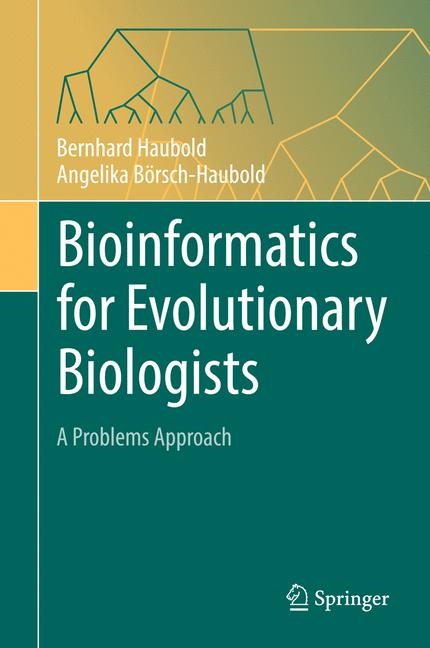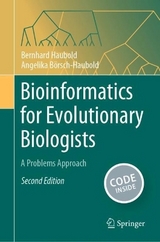
Bioinformatics for Evolutionary Biologists
Springer International Publishing (Verlag)
978-3-319-67394-3 (ISBN)
- Lieferbar
- Versandkostenfrei
- Auch auf Rechnung
- Artikel merken
Bernhard Haubold studied Natural Sciences at Cambridge University, UK and completed his DPhil in Bacterial opulation Genetics at Oxford University, UK in 1998. After training as a Post-Doc at the Max-Planck-Institute for Chemical Ecology in Jena, Germany he worked in the biotech industry before taking on a professorship in Bioinformatics at the University of Applied Sciences, Weihenstephan, Germany in 2003. In 2008, he moved to his current post as a researcher at the Max-Planck-Institute for Evolutionary Biology in Plön, Germany. He also teaches Bioinformatics at Lübeck University. Together with Thomas Wiehe he is the author of Introduction to Computational Biology, An Evolutionary Approach, which was published by Birkhäuser in 2006. Angelika Börsch-Haubold studied Pharmacy at Freiburg University, Germany and Pharmacology at Cambridge University, UK. She completed her DPhil in Pharmacology at Oxford University, UK in 1997, prior to remaining at Oxford for a junior research fellowship. From 2005 to 2008, she taught various courses at the University of Applied Sciences, Weihenstephan, Germany. From 2008 to 2014 she worked as a researcher at the Max-Planck-Institute for Evolutionary Biology in Plön, Germany. She has contributed teaching material to Science in School and was involved in translating the fifth edition of The Molecular Biology of the Cell into German.
lt;p>Part I UNIX.- 1 Getting Started.- 2 Files.- 3 Scripts. Part II Optimal Alignment.- 4 Sequence Evolution.-and Alignment.- 5 Amino Acid Substitution Matrices.- 6 Protein Evolution.- 7 The Number of Possible Alignments.- 8 Dot Plots.- 9 From Dot Plot to Alignment.- 10 Optimal Global Alignment.- 11 Age of the Adh/Adh-dup Gene Duplication in Drosophila.- 12 Optimal and Simplified Local Alignment.- Part III Exact Matching.- Classical Methods.- 14 Suffix Trees.- 16 Text Compression.- Part IV Fast Alignment.-17 Shotgun Sequencing.- 18 Fast Global Alignment.- 19 Fast Local Alignment.- 20 Statistics of Local Alignments.- 21 Clustering of the M. genitalium Proteome.- 22 Position-Dependent Amino Acid Score Matrix: PSI-BLAST.- 23 Optimal Multiple Sequence Alignment.- 24 Heuristic Multiple Sequence Alignment.- Part V Phylogeny.- 26 Rooted Phylogeny.- 27 Unrooted Phylogeny.- Part VI Coalescent.-28 Ancestors.- 29 The Wright-Fisher Model.- 30 The Coalescent.- 31 The Coalescent with Recombinati
on.- Part VII Answers.- References"The book includes more than 40 programs specifically designed for the course. Code is provided for three major operating systems (Unix/Linux, Windows, Mac OS), which omits any possible technological barriers the students may have. That fact along with 400 problems of different levels--from elementary to research--make it an invaluable textbook for evolutionary biology students studying bioinformatics." (Stefka Tzanova, Computing Reviews, June, 2018)
“The book includes more than 40 programs specifically designed for the course. Code is provided for three major operating systems (Unix/Linux, Windows, Mac OS), which omits any possible technological barriers the students may have. That fact along with 400 problems of different levels--from elementary to research--make it an invaluable textbook for evolutionary biology students studying bioinformatics.” (Stefka Tzanova, Computing Reviews, June, 2018)
| Erscheinungsdatum | 11.02.2018 |
|---|---|
| Zusatzinfo | XIII, 318 p. 44 illus., 22 illus. in color. |
| Verlagsort | Cham |
| Sprache | englisch |
| Maße | 155 x 235 mm |
| Gewicht | 654 g |
| Themenwelt | Informatik ► Weitere Themen ► Bioinformatik |
| Naturwissenschaften ► Biologie ► Evolution | |
| Naturwissenschaften ► Biologie ► Genetik / Molekularbiologie | |
| Schlagworte | Bioinformatics • Biology, life sciences • Biomedical and Life Sciences • Computational Biology/Bioinformatics • Computer Appl. in Life Sciences • Evolution • evolutionary biology • Information technology: general issues • Life sciences: general issues • molecular bioinformatics • Molecular Biology • Phylogeny reconstruction • Problem Solving • Sequence Analysis • UNIX command line |
| ISBN-10 | 3-319-67394-7 / 3319673947 |
| ISBN-13 | 978-3-319-67394-3 / 9783319673943 |
| Zustand | Neuware |
| Haben Sie eine Frage zum Produkt? |
aus dem Bereich



